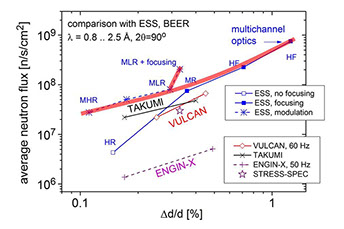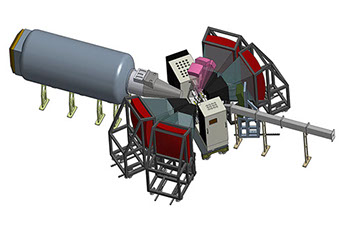
Building Europe’s Next Flagship Engineering Diffractometer: The Future is BEER
Wed Feb 03 11:54:00 CET 2016

The Beamline for European Engineering Materials Research.An innovative combination of research teams and research techniques leads the way to better materials.
A KEY CHALLENGE IN DEVELOPING instruments for ESS is to make the best use of the unique brightness of the neutron source and the pulsed structure of the beam. Collaboration between Czech and German labs has resulted in the design of a novel diffractometer to address that challenge. They call the instrument BEER.
The Beamline for European Engineering Materials Research (BEER) is the realisation of Dr. Petr Lukáš’ research group at the Nuclear Physics Institute (NPI) and the Institute of Physics in the Czech Republic, and Prof. Dr. Andreas Schreyer’s research group—together with an innovative chopper design by Dr. Reinhard Kampmann—at Helmholtz-Zentrum Geesthacht (HZG) in Germany. Their 50/50 collaboration was guided by the ESS Scientific and Technical Advisory Panel (STAP) for Materials and Engineering Diffraction. Currently it is the only engineering diffractometer concept in the plans for the ESS instrument suite.

The BEER concept evolved from two separate proposals previously under development for ESS: the Complex-Environment Engineering Diffractometer (CEED) from the Czech labs, and the Structured Pulse Engineering Diffractometer (SPEED) from the German laboratory. It was not long before CEED and SPEED became BEER.
“When we realised that the two former instrument concepts could actually be merged into a single concept from which both groups could profit,” explains Schreyer, “it became clear we could deliver an instrument concept able to combine the possibilities of worldwide existing instruments with novel concepts for an engineering diffractometer. In this way, [we saw] BEER had the potential to become the new worldwide flagship instrument for engineering materials research.”
BEER is expected to draw a large user community to ESS from groups interested in residual stress mapping and texture analysis, in situ investigations, experiments using the Gleeble® simulator, metallurgy, complementary studies with synchrotron X-rays, and from a broad range of industrial manufacturers. The concept shows there is strong ambition in the materials science community to carry out more studies along the lines that BEER enables.
“Another point that is remarkable about BEER is its integrative character as a project driven by equal partners, and with broad support from the community,” says Dr. Markus Strobl, the ESS coordinator for the Materials and Engineering Diffraction instrument class. “This has especially been reflected in the advice and support received from the STAP, which additionally represents British expertise in the field and that of the corresponding American and Japanese communities.”
Innovative approach leads to innovative materials
BEER enables researchers to create and optimise complex materials in ways not done before. The diffractometer aims to greatly advance scientific understanding of engineering components by providing a finer mapping of their microstructural organisation, and by exposing the fast kinetic changes that occur during industrial processing.
Neutron diffraction is a technique to obtain a pattern that provides information on the atomic structure of a material. It is an established technique for characterising materials stresses, textures, and deformation processes. According to its creators, BEER will allow more flexibility in sample analysis and an increase in usable beam intensity at least one order of magnitude greater than existing neutron diffractometers. It expands the possibilities of investigations of samples that are in situ, but also in operando, or in operation, such as batteries while they are in use.
This more sophisticated understanding of how materials behave is a critical step forward if society is to successfully address global challenges such as sustainable development, mobility, energy conservation, and infrastructure development. It will help Europe compete and maintain a global lead in industrial manufacturing.

BEER’s capabilities are ideally demonstrated in time-resolved in situ and in operando investigations. “True in situ experiments will be possible using dedicated sample environments,” says Lukáš. “That will expose bulk samples of engineering materials to the stress, strain, temperatures, and conditions they experience during real-scale production and processing, or during testing and real application of engineering components.”
Its versatility for use with large volume samples and special sample environments, such as the Gleeble® simulator and Baehr quenching and deformation dilatometer, is expected to vastly improve the simulation of industrial processing and potentially open new areas in the field.
Innovative combinations
Engineering diffraction by itself is not enough to observe the evolution of microstructures when exposed to extreme thermomechanical conditions during processing. To solve this problem, BEER’s design combines methods in a completely novel way: it enables the option to simultaneously obtain Small Angle Neutron Scattering (SANS) and neutron imaging measurements while working as a diffractometer. This solution provides nanoscale data for kinetic processes and detects sample inhomogeneities during the structural transformations.
The instrument will include broad-range neutron optics and a new chopper system. Together, those systems can adjust measurement time, beam intensity, as well as resolution of time-of-flight diffraction. “The greatest challenge had been to find a way to utilise the long neutron pulse of the source for increasing the intensity at the sample beyond what is available today,” explains Schreyer. “We developed a ‘pulse multiplexing’ technique by which the intensity can be increased while a high resolution is preserved.”
Close ties with Industry
The advances BEER offers to researchers have broad implications for society and industry. Dr. Michael Preuss is professor of metallurgy at the University of Manchester and chair of the STAP for Materials and Engineering Diffraction. “Today’s materials, such as advanced engineering steel and superalloys like titanium alloy, are at the limit of what we can do with them,” says Preuss. “BEER will have the greatest impact by enabling the use of structural materials that are incredibly important for transportation and energy. These materials are needed for aircraft engines, power stations, nuclear reactors, deep hole drilling of oil wells and more.”
prove our modern standard of living. Magnesium and aluminium alloys make possible lightweight, fuel-efficient vehicles and aircraft wings; titanium alloys mean better consumer electronics; and shape memory alloys (SMA) are essential for the development of device sensors and super elastic, nickel-free biomedical components.

